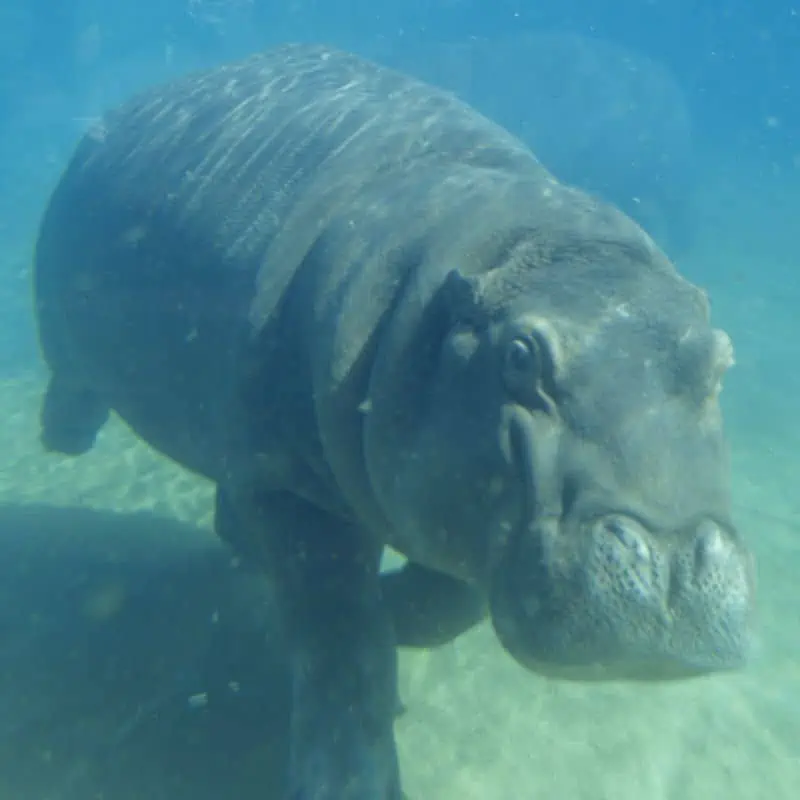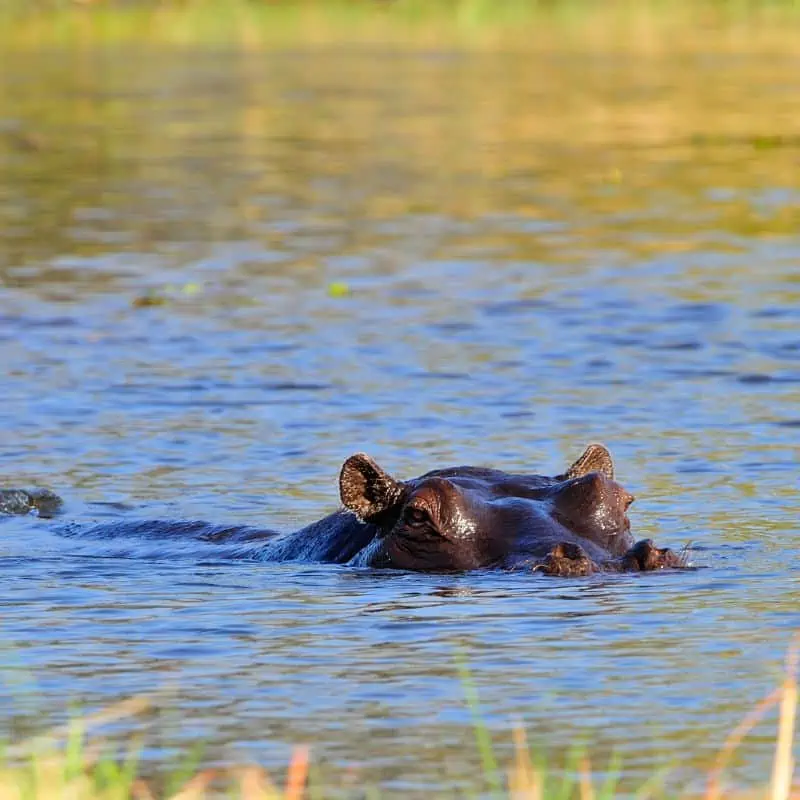In the water, hippos are almost unstoppable. They are surprisingly fast and can easily maneuver through the water. They’re incredibly proficient in the water, but if you had to see them moving below the waterline, you wouldn’t be wrong to wonder, can hippos swim?
In short, no, hippos cannot swim. Hippos move through the water by treading with their big, flat feet and pushing off the river or lake bottom with their powerful legs.
There is a lot more to hippos’ underwater lifestyle that we need to look at, so let’s (excuse the pun) dive in.

Can Hippos Swim?
Hippos can’t swim, despite being semi-aquatic mammals that spend up to 16 hours a day in the water.
It makes sense when you consider that a male hippo can weigh up to 9,920 pounds, and a female can weigh up to 3,000 pounds.
Their massive bodies are extremely dense, making it impossible to float or swim. Yet, this doesn’t stop them from being nimble underwater.
How Do Hippos Move Underwater?
Hippos make do with what they have, so you’ll see them walking or running on the bottom of shallow water. Since their nostrils, eyes, and ears are located on the highest parts of their heads, they can walk for as long as they like.
In other words, they can see or hear threats and breathe normally while most of their body is below the waterline. Does this mean they can drown in deep water? Well, not really.
You see, hippos can hold their breath underwater for up to five minutes. They also have the incredible ability to close their nostrils and ears (already from birth) when completely submerged to prevent water from entering.
The fact that they have eye protection underwater is even more fascinating. To explain, hippos have a transparent membrane covering their eyes. It allows them to keep their eyes open and see clearly as they move around in bodies of water.

Then, when it comes to moving in deep water, hippos are unexpectedly graceful. They propel themselves with their powerful limb muscles, giving the appearance of galloping but at a slow pace.
Hippos aren’t particularly fast in the water; they move at five mph. This speed is still impressive, given how their weight fights through water resistance.
When it’s time to recharge their lungs with oxygen, they push themselves upward for a quick breath and then come back down. Some might compare this technique to astronauts in space touching their feet on a surface and then bouncing back up.
In these cases, hippos can find the water’s bottom to walk, stand, or gallop. Whereas, if the water is deep enough that their feet don’t reach the bottom or they’re unable to reach the surface, they, unfortunately, are at risk of drowning.
Can Hippos Swim in Saltwater?
First off, there are two species of hippo in Africa. The first is the common hippopotamus, also known as the large hippo. The second and much smaller species is the pygmy hippopotamus, which weighs only 400 to 600 pounds.
Large hippos are commonly found in East Africa, south of the Sahara, while pygmy hippos are found in West Africa. Both thrive in freshwater environments such as lakes and rivers.
Nonetheless, herds inhibiting West Africa typically live in estuarine waters and, in some cases, can be seen at sea in Saltwater.
An 8,000-pound male hippo was once seen poking his head above the surface of the Atlantic. Yet, that was an extremely unusual occurrence. The depth and density of an ocean would make it almost impossible for a hippo to survive.
So, no, a hippo cannot swim in saltwater, just like it can’t swim in freshwater.
Do Hippos Sleep Underwater?

Yes, hippos do prefer to sleep underwater. They can sleep not only in shallow water but also in deeper water.
Hippos have a reflex that pushes them up to the surface to get some air whenever they need it. They don’t even open their eyes or wake up; they simply rise to catch their breath and then slowly sink back down.
It may not be surprising to then know that hippos’ closest living relatives are whales.
Why Do Hippos Spend So Much Time in Water?
Hippos love water, so much so that the Greeks named them “Hippopotamuses,” which translates as “river horses.” These magnificent creatures must keep their sensitive skin wet to keep their bodies cool. Otherwise, they run the risk of becoming dehydrated.
For instance, humans can sweat off excess body heat, but hippos lack sweat glands. They rely on water bodies to keep themselves hydrated to deal with the heatwaves and direct sunlight in their natural habitats.
Here’s an interesting fact, hippos do sweat, but it takes a unique form. They secrete a sweat-like liquid from the subdermal glands, commonly called “blood sweat.” It has a different texture than human sweat; instead of being drippy, it’s thicker and oily.
The striking part is that its color is red, which was long assumed that it was actual blood emitted from their bodies. A hippo’s sweat is initially transparent; after a few minutes of air exposure, however, the color changes to red, then to brown.
This color shift was linked to two pigment molecules:
- Hipposudoric acid: Red pigment
- Norhipposudoric acid: Orange pigment
The red mucus layer is hippos’ secret weapon for survival in harsh weather, along with water. It protects them from sunburn by acting as an exceptional natural sunscreen.
Simply put, both pigments absorb direct sunlight, specifically harmful ultraviolet rays ranging between 290 and 400 nanometers. Moreover, Hipposudoric acid, in particular, has shown antibiotic properties that shield hippos from infection.

Final thoughts on hippos swimming
No, hippos cannot swim, but they can move around in water very well. Their inability to swim doesn’t limit their enjoyment of water.
They prefer to spend most of their time underwater and even take shelter in it while sleeping or giving birth.
Besides, their slow-motion pacing while submerged still gets them where they need to be, so we’d say that’s good enough.
